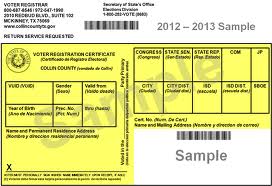The Trib reminds us that there are bigger questions that remain to be answered in the voter ID litigation.
Still the only voter ID anyone should need
The litigation on the state’s voting district maps for legislative and congressional elections is still underway, and the treatment of minority voters and their ability to elect the candidates they choose is at the center of it. A federal court in Washington found that the state had intentionally discriminated in drawing its maps for Texas House districts. That finding has been set aside, but the lawyers suing the state have raised the same issues before another set of judges. The finding could come back.
The voter ID case is infused with some of the same arguments and conclusions that have marked past redistricting and election cases, each adding another brick to the wall of evidence that led the judge in this case to her conclusion.
“This history describes not only a penchant for discrimination in Texas with respect to voting,” she wrote, “but it exhibits a recalcitrance that has persisted over generations despite the repeated intervention of the federal government and its courts on behalf of minority citizens.”
“History” is worth your attention in that sentence. Last year, the U.S. Supreme Court struck down the part of the federal Voting Rights Act that put Texas and other jurisdictions with histories of discrimination under federal supervision. It required those places to get permission, or preclearance, from the Department of Justice for any changes in voting or election laws before putting those laws into effect.
With the Supreme Court’s 2013 ruling, those laws take effect after they are passed, and the Justice Department can come in with other defendants, as it has done in the voter ID case, to try to overturn those laws.
The Supreme Court decision left in place a provision of the Voting Rights Act that could put a state like Texas back under the preclearance provisions — not for historical discrimination, but for current discrimination.
If the voter ID ruling by Gonzales Ramos, an Obama appointee and a Hispanic, stands, it leads in that direction, saying the law’s proponents were motivated at least in part “because of and not merely in spite of the voter ID law’s detrimental effects on the African-American and Hispanic electorate.”
See here, here, and here for more on the Section 3 option for preclearance. Just bear in mind that the whole reason why Texas got to go ahead and implement this discriminatory law is because preclearance under Section 5 was gutted by the Supreme Court. Bringing it back would be huge, and the plaintiffs in both lawsuits can make an argument for it. I very much look forward to the next meeting with the attorneys that Judge Ramos will hold after the election.
Elsewhere, Rick Hasen explains why the SCOTUS ruling on voter ID came down so late.
But every so often court watchers are reminded that these justices are working very hard behind the scenes by reading briefs, exchanging memos, and debating outcomes. Case in point: The justices issued an order and a dissent in a Texas voting rights case at 5 a.m. Saturday morning. Supreme Court reporters stood by all night for the ruling. The holdup apparently was Justice Ruth Bader Ginsburg’s six-page dissent, joined by Justices Elena Kagan and Sonia Sotomayor.
[…]
Sometimes justices disagree with emergency court orders such as these and do not even bother to write a formal dissent. And recently, as Slate’s Dahlia Lithwick has noted, the majority has not been explaining its various orders in cases from voting rights, to abortion, to same sex marriage, at all.
So why did Justice Ginsburg keep the court and court-watchers up all night for a relatively lengthy dissent from an order issued with no majority opinion? There is no way to know from the outside, but my guess is that she wanted to make an important statement about how the Supreme Court should handle these voting cases going forward and to publicly flag where she believes the court is going wrong. Like a rare oral dissent from the bench after a written opinion, this middle-of-the-night dissent calls attention to what Justice Ginsburg likely sees as a grave injustice.
Hasen pessimistically thinks that SCOTUS will eventually uphold Texas’ voter ID law. Interestingly, via the Texas Election Law Blog, one of the big cheerleaders for voter ID says there are no valid legal grounds for an appeal by the defendants, and no likelihood of the decision being overturned by an appellate court. In the Fifth Court of Appeals we trust nothing, but I sure hope he’s right.

